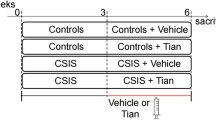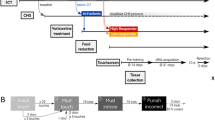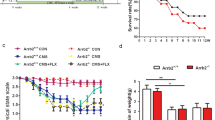Abstract
Aim:
N-methyl-D-aspartic acid (NMDA) receptor modulators have shown promising results as potential antidepressant agents, whereas timosaponins extracted from the Chinese herb Rhizoma Anemarrhenae exhibit antidepressant activities. In the present study we examined whether YY-23, a modified metabolite of timosaponin B-III, could affect NMDA receptors in rat hippocampal neurons in vitro, and evaluated its antidepressant-like effects in stressed mice.
Methods:
NMDA-induced currents were recorded in acutely dissociated rat hippocampal CA1 neurons using a whole-cell recording technique. C57BL/6 mice were exposed to a 6-week chronic mild stress (CMS) or a 10-d chronic social defeat stress (CSDS). The stressed mice were treated with YY-23 (20 mg·kg−1·d−1) or a positive-control drug, fluoxetine (10 mg·kg−1·d−1) for 3 weeks. Behavioral assessments were carried out every week.
Results:
In acutely dissociated rat hippocampal CA1 neurons, YY-23 selectively and reversibly inhibited NMDA-induced currents with an EC50 value of 2.8 μmol/L. This inhibition of NMDA-induced currents by YY-23 was non-competitive, and had no features of voltage-dependency or use-dependency. Treatment of the stressed mice with YY-23 not only reversed CMS-induced deficiency of sucrose preference and immobility time, and CSDS-induced reduction of social interaction, but also had faster onset as compared to fluoxetine.
Conclusion:
YY-23 is a novel non-competitive antagonist of NMDA receptors with promising rapid antidepressant-like effects in mouse models of CMS and CSDS depression.
Similar content being viewed by others
Log in or create a free account to read this content
Gain free access to this article, as well as selected content from this journal and more on nature.com
or
References
Krishnan V, Nestler EJ . The molecular neurobiology of depression. Nature 2008; 455: 894–902.
Belmaker RH, Agam G . Major depressive disorder. N Engl J Med 2008; 358: 55–68.
Davidson JR . Major depressive disorder treatment guidelines in America and Europe. J Clin Psychiatry 2010; 71 Suppl E1: e04.
Gelenberg AJ . A review of the current guidelines for depression treatment. J Clin Psychiatry 2010; 71: e15.
Lapidus KA, Soleimani L, Murrough JW . Novel glutamatergic drugs for the treatment of mood disorders. Neuropsychiatr Dis Treat 2013; 9: 1101–12.
Duman RS, Voleti B . Signaling pathways underlying the pathophysiology and treatment of depression: novel mechanisms for rapid-acting agents. Trends Neurosci 2012; 35: 47–56.
Larkin GL, Beautrais AL . A preliminary naturalistic study of low-dose ketamine for depression and suicide ideation in the emergency department. Int J Neuropsychopharmacol 2011; 14: 1127–31.
Li N, Lee B, Liu RJ, Banasr M, Dwyer JM, Iwata M, et al. mTOR-dependent synapse formation underlies the rapid antidepressant effects of NMDA antagonists. Science 2010; 329: 959–64.
Jourdi H, Hsu YT, Zhou M, Qin Q, Bi X, Baudry M . Positive AMPA receptor modulation rapidly stimulates BDNF release and increases dendritic mRNA translation. J Neurosci 2009; 29: 8688–97.
Preskorn SH, Baker B, Kolluri S, Menniti FS, Krams M, Landen JW . An innovative design to establish proof of concept of the antidepressant effects of the NR2B subunit selective N-methyl-D-aspartate antagonist, CP-101,606, in patients with treatment-refractory major depressive disorder. J Clin Psychopharmacol 2008; 28: 631–7.
Pilc A, Wieronska JM, Skolnick P . Glutamate-based antidepressants: preclinical psychopharmacology. Biol Psychiatry 2013; 73: 1125–32.
Murrough JW, Charney DS . Cracking the moody brain: lifting the mood with ketamine. Nat Med 2010; 16: 1384–5.
Murrough JW, Charney DS . Is there anything really novel on the antidepressant horizon? Curr Psychiatry Rep 2012; 14: 643–9.
Reus GZ, Stringari RB, Ribeiro KF, Ferraro AK, Vitto MF, Cesconetto P, et al. Ketamine plus imipramine treatment induces antidepressant-like behavior and increases CREB and BDNF protein levels and PKA and PKC phosphorylation in rat brain. Behav Brain Res 2011; 221: 166–71.
Neis VB, Moretti M, Manosso LM, Lopes MW, Leal RB, Rodrigues AL . Agmatine enhances antidepressant potency of MK-801 and conventional antidepressants in mice. Pharmacol Biochem Behav 2015; 130: 9–14.
Behrens MM, Ali SS, Dao DN, Lucero J, Shekhtman G, Quick KL, et al. Ketamine-induced loss of phenotype of fast-spiking interneurons is mediated by NADPH-oxidase. Science 2007; 318: 1645–7.
Zhu WL, Ma SP, Qu R, Kang DL, Liu YD . Antidepressant effect of baicalin extracted from the root of Scutellaria baicalensis in mice and rats. Pharm Biol 2006; 44: 503–10.
Ren LX, Luo YF, Li X, Zuo DY, Wu YL . Antidepressant-like effects of sarsasapogenin from Anemarrhena asphodeloides BUNGS (Liliaceae). Biol Pharma Bull 2006; 29: 2304–6.
Wang R, Yan H, Tang XC . Progress in studies of huperzine A, a natural cholinesterase inhibitor from Chinese herbal medicine. Acta Pharmacol Sin 2006; 27: 1–26.
Guo Y, Zhang H, Chen X, Cai W, Cheng J, Yang Y, et al. Evaluation of the antipsychotic effect of bi-acetylated l-stepholidine (l-SPD-A), a novel dopamine and serotonin receptor dual ligand. Schizophr Res 2009; 115: 41–9.
Matsuda H, Sato N, Yamazaki M, Naruto S, Kubo M . Testosterone 5 alpha-reductase inhibitory active constituents from Anemarrhenae Rhizoma. Biol Pharm Bull 2001; 24: 586–7.
Jiang W, Guo J, Xue R, Zhu K, Li Z, Chen M, et al. Anti-depressive activities and biotransformation of timosaponin B-III and its derivatives. Nat Prod Res 2014; 28: 1446–53.
Li TJ, Qiu Y, Yang PY, Rui YC, Chen WS . Timosaponin B-II improves memory and learning dysfunction induced by cerebral ischemia in rats. Neurosci Lett 2007; 421: 147–51.
Guo F, Zhang Q, Zhang B, Fu Z, Wu B, Huang C, et al. Burst-firing patterns in the prefrontal cortex underlying the neuronal mechanisms of depression probed by antidepressants. Eur J Neurosci 2014; 40: 3538–47.
Zhang JM, Hu GY . Huperzine A, a nootropic alkaloid, inhibits N-methyl-D-aspartate-induced current in rat dissociated hippocampal neurons. Neuroscience 2001; 105: 663–9.
Sodickson DL, Bean BP . Neurotransmitter activation of inwardly rectifying potassium current in dissociated hippocampal CA3 neurons: interactions among multiple receptors. J Neurosci 1998; 18: 8153–62.
Willner P . The validity of animal models of depression. Psychopharmacology (Berl) 1984; 83: 1–16.
Willner P . Chronic mild stress (CMS) revisited: consistency and behavioural-neurobiological concordance in the effects of CMS. Neuropsychobiology 2005; 52: 90–110.
Ageta H, Murayama A, Migishima R, Kida S, Tsuchida K, Yokoyama M, et al. Activin in the brain modulates anxiety-related behavior and adult neurogenesis. PLoS One 2008; 3: e1869.
Taniguchi S, Nakazawa T, Tanimura A, Kiyama Y, Tezuka T, Watabe AM, et al. Involvement of NMDAR2A tyrosine phosphorylation in depression-related behaviour. EMBO J 2009; 28: 3717–29.
Stuart MJ, Corrigan F, Baune BT . Knockout of CXCR5 increases the population of immature neural cells and decreases proliferation in the hippocampal dentate gyrus. J Neuroinflammation 2014; 11: 31.
Golden SA, Covington HE, 3rd, Berton O, Russo SJ . A standardized protocol for repeated social defeat stress in mice. Nat Protoc 2011; 6: 1183–91.
Tsankova NM, Berton O, Renthal W, Kumar A, Neve RL, Nestler EJ . Sustained hippocampal chromatin regulation in a mouse model of depression and antidepressant action. Nat Neurosci 2006; 9: 519–25.
Gilling KE, Jatzke C, Hechenberger M, Parsons CG . Potency, voltage-dependency, agonist concentration-dependency, blocking kinetics and partial untrapping of the uncompetitive N-methyl-D-aspartate (NMDA) channel blocker memantine at human NMDA (GluN1/GluN2A) receptors. Neuropharmacology 2009; 56: 866–75.
Frankiewicz T, Potier B, Bashir ZI, Collingridge GL, Parsons CG . Effects of memantine and MK-801 on NMDA-induced currents in cultured neurones and on synaptic transmission and LTP in area CA1 of rat hippocampal slices. Br J Pharmacol 1996; 117: 689–97.
Huettner JE, Bean BP . Block of N-methyl-D-aspartate-activated current by the anticonvulsant MK-801: selective binding to open channels. Proc Natl Acad Sci U S A 1988; 85: 1307–11.
Willner P . Validity, reliability and utility of the chronic mild stress model of depression: a 10-year review and evaluation. Psychopharmacology (Berl) 1997; 134: 319–29.
Fuchs E, Flugge G . Social stress in tree shrews: effects on physiology, brain function, and behavior of subordinate individuals. Pharmacol Biochem Behav 2002; 73: 247–58.
Johnson JW, Kotermanski SE . Mechanism of action of memantine. Curr Opin Pharmacol 2006; 6: 61–7.
LePage KT, Ishmael JE, Low CM, Traynelis SF, Murray TF . Differential binding properties of [3H]dextrorphan and [3H]MK-801 in heterologously expressed NMDA receptors. Neuropharmacology 2005; 49: 1–16.
Parsons CG, Gruner R, Rozental J, Millar J, Lodge D . Patch clamp studies on the kinetics and selectivity of N-methyl-D-aspartate receptor antagonism by memantine (1-amino-3,5-dimethyladamantan). Neuropharmacology 1993; 32: 1337–50.
Parsons CG, Danysz W, Quack G . Memantine is a clinically well tolerated N-methyl-D-aspartate (NMDA) receptor antagonist - a review of preclinical data. Neuropharmacology 1999; 38: 735–67.
McKay S, Bengtson CP, Bading H, Wyllie DJ, Hardingham GE . Recovery of NMDA receptor currents from MK-801 blockade is accelerated by Mg2+ and memantine under conditions of agonist exposure. Neuropharmacology 2013; 74: 119–25.
Gambarana C, Scheggi S, Tagliamonte A, Tolu P, De Montis MG . Animal models for the study of antidepressant activity. Brain Res Brain Res Protoc 2001; 7: 11–20.
Forbes NF, Stewart CA, MAtthews K, Reid IC . Chronic mild stress and sucrose consumption: Validity as a model of depression. Physiol Behav 1996; 60: 1481–4.
Nestler EJ, Hyman SE . Animal models of neuropsychiatric disorders. Nat Neurosci 2010; 13: 1161–9.
Donahue RJ, Muschamp JW, Russo SJ, Nestler EJ, Carlezon WA, Jr . Effects of striatal DeltaFosB overexpression and ketamine on social defeat stress-induced anhedonia in mice. Biol Psychiatry 2014; 76: 550–8.
Berton O, McClung CA, Dileone RJ, Krishnan V, Renthal W, Russo SJ, et al. Essential role of BDNF in the mesolimbic dopamine pathway in social defeat stress. Science 2006; 311: 864–8.
Trullas R, Skolnick P . Functional antagonists at the NMDA receptor complex exhibit antidepressant actions. Eur J Pharmacol 1990; 185: 1–10.
Skolnick P, Popik P, Trullas R . Glutamate-based antidepressants: 20 years on. Trends Pharmacol Sci 2009; 30: 563–9.
Papp M, Moryl E . New evidence for the antidepressant activity of MK-801, a non-competitive antagonist of NMDA receptors. Pol J Pharmacol 1993; 45: 549–53.
Papp M, Moryl E . Antidepressant activity of non-competitive and competitive NMDA receptor antagonists in a chronic mild stress model of depression. Eur J Pharmacol 1994; 263: 1–7.
Redmond AM, Harkin A, Kelly JP, Leonard BE . Effects of acute and chronic antidepressant administration on phencyclidine (PCP) induced locomotor hyperactivity. Eur Neuropsychopharmacol 1999; 9: 165–70.
Zarate CA, Jr, Singh JB, Carlson PJ, Brutsche NE, Ameli R, Luckenbaugh DA, et al. A randomized trial of an N-methyl-D-aspartate antagonist in treatment-resistant major depression. Arch Gen Psychiatry 2006; 63: 856–64.
Diazgranados N, Ibrahim L, Brutsche NE, Newberg A, Kronstein P, Khalife S, et al. A randomized add-on trial of an N-methyl-D-aspartate antagonist in treatment-resistant bipolar depression. Arch Gen Psychiatry 2010; 67: 793–802.
Krystal JH, Sanacora G, Duman RS . Rapid-acting glutamatergic antidepressants: the path to ketamine and beyond. Biol Psychiatry 2013; 73: 1133–41.
Autry AE, Adachi M, Nosyreva E, Na ES, Los MF, Cheng PF, et al. NMDA receptor blockade at rest triggers rapid behavioural antidepressant responses. Nature 2011; 475: 91–5.
Stone JM, Dietrich C, Edden R, Mehta MA, De Simoni S, Reed LJ, et al. Ketamine effects on brain GABA and glutamate levels with 1H-MRS: relationship to ketamine-induced psychopathology. Mol Psychiatry 2012; 17: 664–5.
Krystal JH, D'Souza DC, Mathalon D, Perry E, Belger A, Hoffman R . NMDA receptor antagonist effects, cortical glutamatergic function, and schizophrenia: toward a paradigm shift in medication development. Psychopharmacology (Berl) 2003; 169: 215–33.
Chowdhury GM, Behar KL, Cho W, Thomas MA, Rothman DL, Sanacora G . 1H-[13C]-nuclear magnetic resonance spectroscopy measures of ketamine's effect on amino acid neurotransmitter metabolism. Biol Psychiatry 2012; 71: 1022–5.
Acknowledgements
This work was supported by the National Natural Science Foundation (31128009 and 31171011 to Yang LI), the National Science & Technology Major Project 'Key New Drug Creation and Manufacturing Program' (2014ZX09102-001-005 to Cheng-gang HUANG), and the Ministry of Science and Technology (2013CB910601 to Yang LI).
Author information
Authors and Affiliations
Corresponding authors
Rights and permissions
About this article
Cite this article
Zhang, Q., Guo, F., Fu, Zw. et al. Timosaponin derivative YY-23 acts as a non-competitive NMDA receptor antagonist and exerts a rapid antidepressant-like effect in mice. Acta Pharmacol Sin 37, 166–176 (2016). https://doi.org/10.1038/aps.2015.111
Received:
Accepted:
Published:
Issue date:
DOI: https://doi.org/10.1038/aps.2015.111
Keywords
This article is cited by
-
Prefrontal AMPA receptors are involved in the effect of methylphenidate on response inhibition in rats
Acta Pharmacologica Sinica (2018)
-
Identifying fast-onset antidepressants using rodent models
Molecular Psychiatry (2017)



